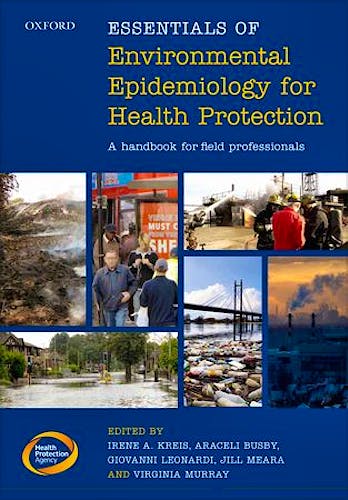

No hay productos en el carrito



Essentials of Environmental Epidemiology for Health Protection: A Handbook for Field Professionals
Kreis, I. — Busby, A. — Leonardi, G. — Meara, J. — Murray, V.
1ª Edición Noviembre 2012
Inglés
Tapa blanda
296 pags
482 gr
18 x 25 x 1 cm
ISBN 9780199663415
Editorial OXFORD
LIBRO IMPRESO
-5%
71,89 €68,30 €IVA incluido
69,13 €65,67 €IVA no incluido
Recíbelo en un plazo de
2 - 3 semanas
About this book
- Produced by an expert team at the Health Protection Agency, providing an authority and insight on the subject
- Provides practical instruction on how to plan and carry out studies
- Emphasises the scoping and planning stages of a study in order to avoid common pitfalls and aid learning
Essentials of Environmental Epidemiology for Health Protection guides front line public health practitioners through the decisions they are likely to face when dealing with environmental health problems. It does this by showing how to integrate relevant aspects of environmental science, communication sciences, toxicology, and most importantly environmental epidemiology skills to conduct initial investigations which encompass all relevant issues.
The book uses a problem orientated style, using case studies, to provide practical examples of how to plan and carry out investigations or research projects. It emphasises the scoping and planning stages of a study in order to avoid common pitfalls, and includes discussions of the limitations of epidemiological studies, how to communicate with the public and funders, ethics and handling large datasets. Through the case studies the book also covers the practice of environmental public health in developed countries.
Each chapter is written by knowledgeable practitioners in the topic, making Essentials of Environmental Epidemiology for Health Protection essential reading for all professionals in environmental public health in the UK and abroad.
Readership: Health protection staff including medical practitioners, public health professionals in both the UK and abroad, local and regional service staff, students studying courses in public health, and academics teaching environmental health and environmental public health.
Table of contents
Section 1 Identifying the problem
1: Irene A. Kreis: Introduction to Environmental Epidemiology for Health Protection,
illustrated with a case study on lead through the ages
2: Giovanni Leonardi: Epidemiology of environmental hazards, illustrated with
a case study on landfill concerns and water (acute and chronic issues)
3: Irene A. Kreis and David Cromwell: Literature reviews, systematic but how
and why? Illustrated with case studies on dioxin
4: Fred Woudenberg: Communication in epidemiological studies, illustrated with
a case study on a gas-factory terrain clean-up
5: Harrie van Dijk and Wilfried Notten: Identifying and dealing with high-risk
groups systematically and transparently, illustrated with a case study on Q
fever
6: Oliver Morgan and Sue Odams: Health registers as a tool for disaster epidemiology,
illustrated with a case study on a fireworks explosion
Section 2 Assessing the problems and developing a scoping study
7: Sotiris Vardoulakis: Environmental measurements, illustrated with a case
study on ambient air pollution
8: Ariana Zeka: Exposure assessment for epidemiology, illustrated with a case
study on air quality in schools
9: Virginia Murray and Rachel MacLehose: Toxicology and its practical use in
chemical incident response, illustrated with a case study on mercury
10: Raquel Duarte-Davidson: Risk assessment, illustrated with a case study on
carcass removal in a Foot & Mouth epidemic
11: Sam Bracebridge, Alex Elliot, and Gillian Smith: Real-time syndromic surveillance,
illustrated with a case study on an oil depot explosion
12: Rebecca Close, Mike Studden, Araceli Busby, and Giovanni Leonardi: Routine
data, illustrated with a case study on carbon monoxide
13: Leslie Jones: Geographic Information Services (GIS), illustrated with a
case study on Legionaires' disease outbreak
Section 3 Environmental epidemiology design and problem analysis
14: Irene A. Kreis and David Cromwell: Study designs for public health investigations:
basic concepts and practice, illustrated with a case study on asthma
15: Helen Maguire,Irene.A. Kreis, and Virginia Murray: Field epidemiology: logistics,
illustrated with case studies on a Legionella outbreak and a child blood lead
survey
16: Araceli Busby: Data quality, illustrated with a case study on congenital
eye defects
17: Dominik Zenner: Applied statistical techniques, illustrated with case studies
on a cancer cluster and PCB in human milk
18: Sue Odams: Ethics in environmental epidemiology, illustrated with a case
study on lead levels in children
Section 4 Special topics
19: Marjon Drijver, Araceli Busby, and Irene A. Kreis: Cluster investigations,
illustrated with a case study on childhood leukaemia in a cut-flower community
20: Virginia Murray: Occupational epidemiology, illustrated with a case study
on bladder cancer
21: Colin Muirhead and Jill Meara: Radiation, illustrated with case studies
on extremely low frequency electromagnetic fields and radiofrequency electromagnetic
fields
22: Catriona Carmichael and Graham Bickler: Heatwave plan evaluation
23: Carla Stanke: Analysis of mental health impacts of flooding
24: Virginia Murray: Chemical Incidents, illustrated with a case study on an
oil depot explosion
25: Helen Smethurst: Odours incidents and epidemiology, illustrated with a case
study on trans-border transmissions
26: Irene A. Kreis and David A. Griffiths: Decision model for an investigation,
illustrated with a case study on odours and dust
Index
© 2025 Axón Librería S.L.
2.149.0